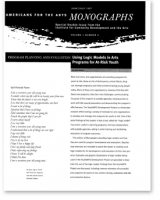Monograph: Program Planning and Evaluation: Using Logic Models in Arts Programs for At-Risk Youth
GENERAL
More and more, arts organizations are providing programs for youth at risk, those at risk of delinquency, school failure, drug use, teenage pregnancy and other problems facing young people today. Many of these arts organizations, however, find that with these new programs, they face new challenges: communicating the goals of the program to outside agencies, training artists to work with this special population and documenting the program's effectiveness. The YouthARTS Development Project is a three-year research effort testing a variety of methods for arts organizations to develop and manage arts programs for youth at risk. One of the early findings of this project is that a tool called the logic model has proven useful in planning programs, forming collaborations with outside agencies, aiding in artist training and facilitating evaluation of program outcomes.
This edition of Monographs describes logic models and how they are used for program development and evaluation. Step-by-step exercises are included to assist the reader in creating such logic models for the development and evaluation of their own projects. Examples and graphic illustrations of logic models being used in the YouthARTS Development Project are provided to illustrate the use of the logic model. Findings from the YouthARTS Project are discussed, including common elements of successful arts programs for youth at risk, artists training, evaluation and risk and protective factors.
A logic model is a graphic representation that clearly identifies and charts the relationships between a program's conditions (needs), activities, outcomes and impacts. The logic model is a planning tool that lays out how and why a program works. The model helps program developers and staff organize and present how the program will affect participants, what kinds of outcomes are expected and why. It also identifies a series of testable mechanisms through which change occurs, and includes succinct, logical concepts or statements that link problems, activities and outcomes. The logic model is effective because it helps program planners articulate the desired outcomes of the program clearly and succinctly in an outcomes oriented design. Standard program plans are means-oriented, providing information about how the program will work, what services will be provided, who will staff the program, where it will occur. An outcomes-oriented approach requires planners to state clearly what effect the program should achieve. That is, why the program design will work. Carefully planning program activities is just as important in an outcomes-oriented approach, but by identifying the desired outcomes first, activities can be efficiently focused on achieving the ultimate goals of the program. (p. 1, 2)
Americans for the Arts’ Monograph series featured in-depth issue papers on topics that were of the greatest interest to our members and arts professionals at the time. They often still serve as excellent resources for best practices and historic reference for today’s issues. Monographs were produced from 1993–2010. Monographs from 2001-2010 are available for downloadable in PDF format our online store at a nominal fee for nonmembers but free to members. All monographs from 1993-2000 are available for free download via the National Arts Administration and Policy Publications Database.
BIBLIOGRAPHY






